From the lush green floor of the valley I gazed toward the encircling dusky blue mountains. Puffy white clouds drifted lazily across the sky, allowing the sun to peek through just enough to make the afternoon comfortably warm. A week earlier the village of Breb, Romania, had been sweltering in a heat wave that caused wells to run dry. But my arrival was timed perfectly – temperatures had moderated to the mid-70’s, perfect walking weather.
With only one paved road, I relied on footpaths that wandered through gardens overflowing with colossal heads of cabbage and fat ears of golden-tasseled corn. Ruby-red tomatoes were bursting their skins and green-black zucchini hung heavy on their vines. Stealthily, I opened a wire metal gate and crept through a farm yard, passing just a few feet from the front door of an old wooden cabin constructed from wide wooden planks, dovetailed together without the aid of nails. I felt like a sneak-thief but the owners of the hostel where I was staying, Babou Maramures, insisted that walking through private property was perfectly acceptable; everyone uses the footpaths, including cows, chickens, and pigs.
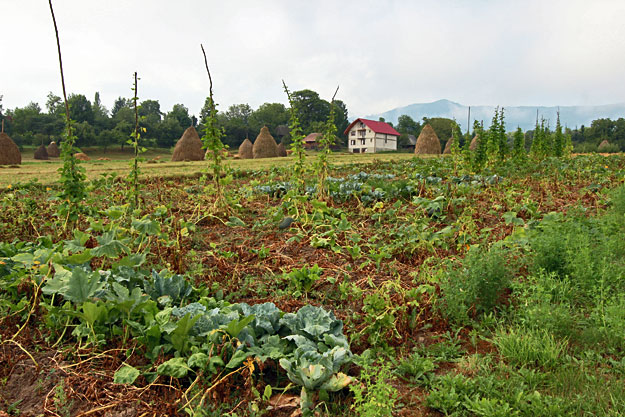
In years past, almost every home in Maramures County had an ornate wooden gateway (poarta maramuresana) at its entrance. During my walks around Breb I spied several of these hand-carved portals, which featured astrological symbols, flowers, animals, people, and in one case even a complete tree of life. Unfortunately, as older gates weather and deteriorate they are not being replaced; these days only wealthier families can bear the cost of such an elaborate portal. However every yard still holds at least one tall wooden tub with a heavy wooden lid. In late summer, apples from the area’s abundant orchards are tossed in and left to ferment. The resultant mash is distilled into Tuica, a fruit brandy that has greater than 50% alcohol content, much the same as the Palinka produced from plums just over the border in Szatmár, Hungary.
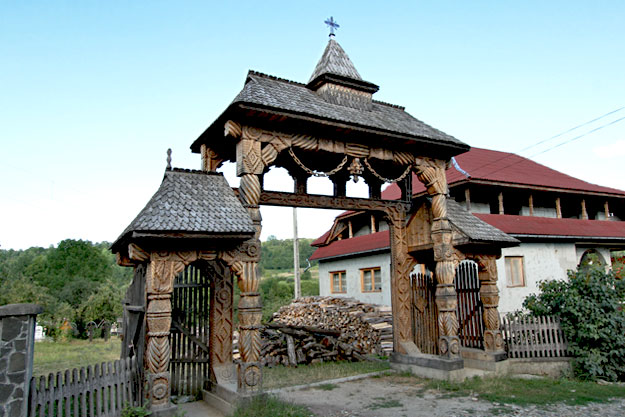

I strolled down a faint path in the grass between gnarled trees, breathing in the scent of apples rotting on the ground mingled with newly mown hay. The orchard opened onto a broad golden meadow where a farmer and his wife were building a haystack from hay that had been drying on the ground. Using a three-pronged pitchfork carved from a tree limb, the farmer tossed a forkful up to his wife, perched at the very top of the two-story stack. She caught it with a rudimentary wooden rake, threw it on top of the pile, and tamped it down with her feet. I waved and pointed first to my camera, then back at them with a questioning look. They invited me over with big grins. My mind was reeling as I snapped photos. I could work out how the woman got to the top: they started from the bottom and built it up a layer at a time. But how on earth was she going to get down? There was no ladder in sight and we were at least a half-mile from the nearest house. As if reading my mind, the farmer shot me sly look and picked up a long, thick tree limb lying nearby in the field stubble. He leaned it against the haystack and held it steady at the bottom. His wife, who had to be 50 years old if she was a day, shimmied down that pole like a teenager.
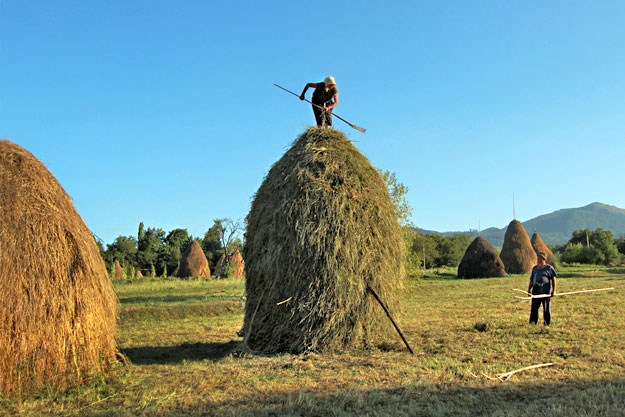
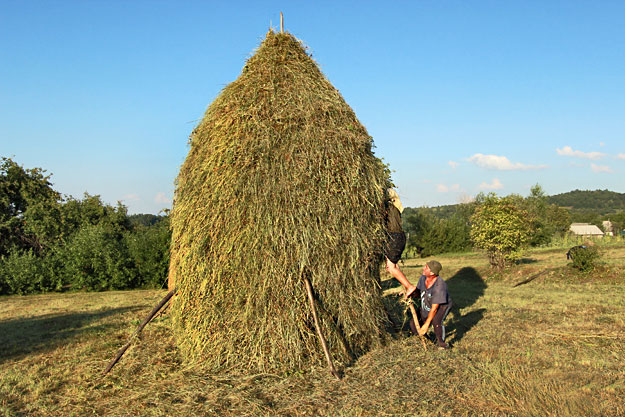
I couldn’t shake the feeling that I’d climbed into a time machine and been swept back 1,000 years. Because the soil is too rocky for mechanized farming, most of the planting and harvesting is still done by hand. At the end of each day, men and women return from the fields wielding hand-carved rakes and giant scythes over their shoulders. Fruits and vegetables are picked by hand and carried in wicker baskets that the women strap to their backs.

There are very few cars and the locals either walk or ride in horse-drawn wagons. Even public transportation hearkens back to days of yore. Riding the Mocanita, the last still operating steam train in the region of Maramures, is a real treat. Two small shops in the village sell the few necessities that must be purchased, such as olive oil and batteries, but for the most part theirs is a subsistence lifestyle. They eat what they grow or raise, build homes from trees in the surrounding forest, and drink water from deep wells in their yards. The family cow, which lives its entire life inside a barn, provides milk each day, from which yogurt butter are made. Goat milk is made into a delicious, pungent cheese. Chickens and pigs live in a crawlspace beneath their houses, coming and going freely via ramps leading to small wooden doors in the stone foundation. Most residents have now have electricity and flush toilets, but many of the women still wash their clothes by hand in streams. And when the brutal winters descend, wood-fired ceramic stoves provide the only source of heat.
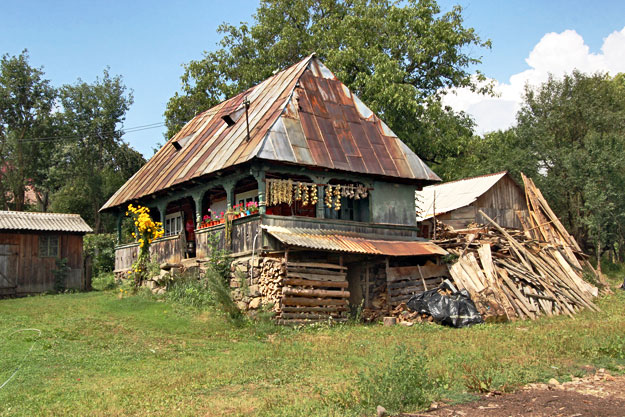
I’d been tipped off that Sunday was the best possible time to be in Breb, as the locals dress up in their best clothes to attend church. The problem was, which of the two churches – the old wooden church or the newer one, with its towering white and gray steeples? Ultimately, the choice was made for me. Unable to see either church from the footpaths, I followed the sound of bells calling locals to worship service and found myself at the old wooden church, St. Archangels Michael and Gabriel. Only one parishioner had shown up. Stooped over with age, the woman laboriously climbed the hill to the church door and stopped briefly to kiss the icon at the door before proceeding inside.
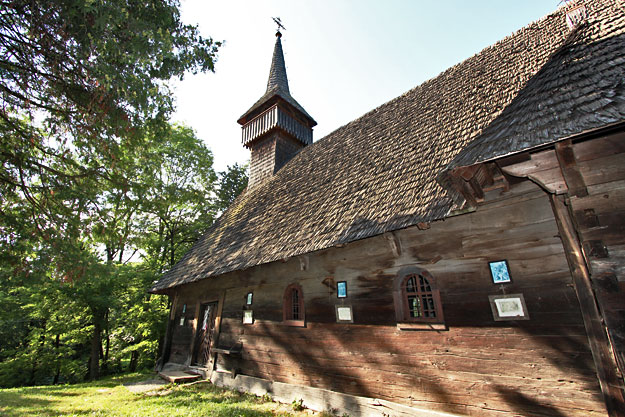
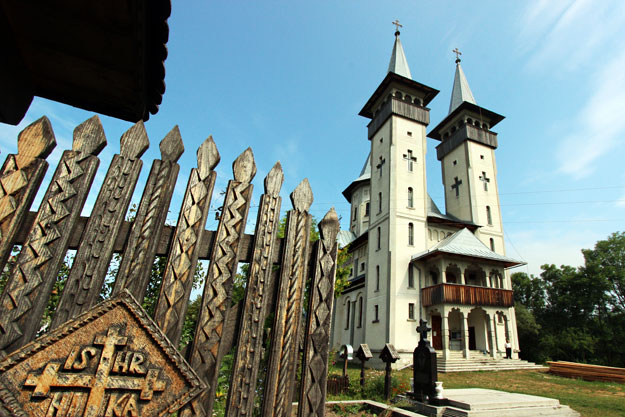
Not wanting to intrude, I left when the service began and quickly retraced my steps to the new church, just in time to see the rest of the community pouring out the front doors. The women were a study in monotones, wide black skirts puffed up with underlying layers of white crinoline, topped by blinding white blouses with puffed sleeves and elaborate collars decorated with eyelet stitching. Sensible flat black shoes and a black floral head scarf, which provided the only splash of color, completed their outfits. The men were dressed in more modern trousers and muted striped shirts, but topped their outfits with a ridiculously small straw hat shaped like an upside-down bell that was entirely too small for their heads.
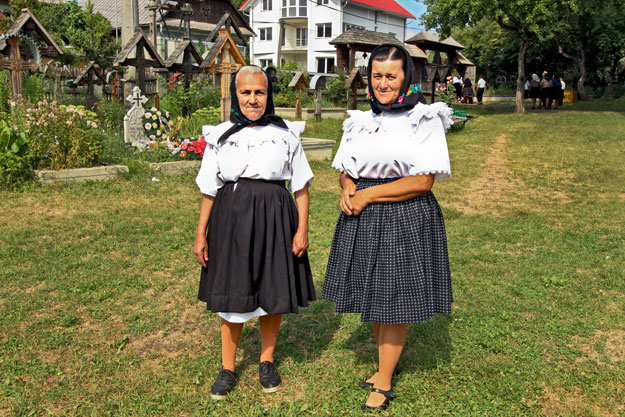
After the churchyard cleared out, I strolled through the adjacent cemetery, examining elaborate carved crosses topped with semi-circular tin roofs that stood at the head of every grave. I was puzzling over the dichotomy between the monochromatic apparel of the locals and the riotous colors of the headstones when I turned a corner into to the rear yard of the church. There, amidst weed-choked older crosses, stood a young woman in a purple T-shirt, bright floral on black skirt, and wild black checkered lace hose. Her only concessions to the local fashion were her flat black shoes and plain ivory headscarf. I felt a certain kinship with her. My family thinks I’m a bit crazy to have walked away from a good career to travel the world, barely scraping by financially. I sensed that she, too, walked her own path and was delighted when she allowed me to take her photo.

Tourism in Breb is still rare. Very few of the locals speak English, though they are friendly and welcoming and do their best to communicate however possible. One afternoon I was strolling down the main road and said “good afternoon” in Romanian to a ruddy-faced woman standing at wooden gate to her family compound. “Angol (English)?” she asked. “Nu, american,” I replied. She stepped over the threshold and motioned for me to follow. Within was her house and barn, plus two lovely guest rooms that she rents out for about $12 per night. We hit it off and before I knew it I’d agreed to come to dinner the following evening, at a cost of 20 Romanian leu (about $6 USD). The delicious vegetarian meal (soup, pancakes stuffed with jam and honey, cheese-stuffed peppers, a fresh tomato and cucumber salad, and fresh-baked bread) was shared with a Norwegian couple who was staying in one of the guest rooms. Afterward, Maria’s son tried to start a conversation. Because I speak Spanish and Romanian is also a Latin-based language, I was able to figure out that he had worked in Italy for a number of years and spoke fluent Italian. I switched to Spanish, which is similar enough to Italian that we could understand each other and we had a three-way discussion, with me translating into English for the Dutch couple. I never cease to be amazed by the human ability to communicate in the most difficult circumstances.
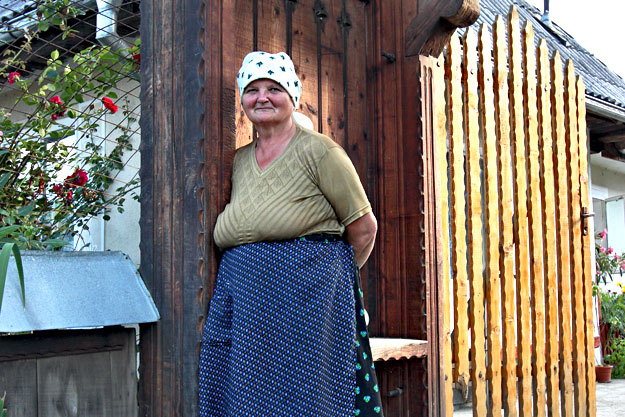
Fortunately, the owners of the hostel and campground where I lodged speak both Romanian and English, so it was easy to find my way around Breb once I arrived, but getting there takes some doing. I was lucky, in that my friends Zsuzsa and Ambrus from Panyola, Hungary, wanted to go camping for the weekend, so they drove me to there. When it was time to leave the owner of the hostel, Matthias, drove me up to the main road to flag down the minibus to Baia-Mare, where I could catch a bus to Cluj-Napoca. Moments later, a car with Michigan license plates stopped to ask for directions! Inside were three men, one who still lives in Romania and two who had immigrated to the U.S. in the mid-80’s. They now live in Ann Arbor, Michigan but return every year to visit family. This time they decided to ship a car over, which they woud drive during their vacation and leave behind for future use.
Matthias asked them if they’d mind taking me to Baia Mare, which was on their way, and they were happy to do so. The two U.S. citizens, one a retired pig farmer and the other a long-haul truck driver, were, quite simply, astounded to see me. “If you’d asked me if I would ever meet an American woman traveling alone in the remote northern area of Transylvania, I would have bet it could never happen,” one of the men said. I just laughed and said, “I get that a lot.” In the end, I was the one most fascinated. The two had fled Romania during the Communist era and one of them told me what it was like to arrive in the U.S. “I still remember walking into a K-Mart for the first time and being stunned by all the products, by the choices you had.”
People I meet along the way are the true rewards of travel, but the best experiences inevitably happen in out-of-the-way places that haven’t yet been impacted by tourism. Breb definitely qualifies.

As a local tour organizer I can confirm it is a great description of the village. I am visiting Maramures area at least two times for year. The place changed in the last years thanks (or due) the tourism activity. A very nice description of the original place you can find in a novel written in the ’90s by Mr. William Blacker – „Along the enchanted way”.
There are still hidden places in Maramures/Romania not touched by modern life, but we are trying to keep them secret 😉
Thank you for visiting my country and for the beautiful description!
Thank you so much for your kind words Ionut. Breb is an enchanted place.
Hey, there. Just revisited this post as it came up in a Pinterest feed. We lived in Breb for 3 years, on and off. We’ve left , for now. Maybe we’ll go back. You’d see a lot of changes in Breb if you went back now. The house with the tin roof there now has a new one, plastic. The old shop and pub next door to that one have been demolished and there’s a brand new, huge hotel there, the shop has been re-built a little further down. The old ways are dying. Kids don’t want to be farmers any more unfortunately, so off they go to the cities. But those 3 years we spent there were magic.Particularly the winters and Christmas traditions. We have good friends and wonderful memories. We hope to be back there this winter for a while.
Hi Alyson. I’m very sad to hear that so much is changing there. It’s an idyllic place, but I guess change is unavoidable once the tourists discover a place.
My cousin and I visited Romania three years ago. Her father was born in Piatra Neam? in the early part of the 19th century. We decided to make a trip there to visit as much of the country as possible. We have been fortunate to travel the world and experience many beautiful sights and have many wonderful adventures; however, I still dream of Romania and, in particular, Breb.
It is, like most of Romania, enchanting. Breb especially captured my heart — the people, the countryside, the animals! While walking or cycling the area, you meet artisans who invite you into their homes to show you their crafts: shoemakers, weavers, carvers. Petru Pop was one such person I will never forget and whom we found quite by accident! As you mentioned, people carry their baskets and long, hand-carved garden utensils home. While walking along winding beautiful pathways, my cousin and I met a woman and offered to help carry her load…as a result, she took us home to meet Petru Pop…what a joy! We managed to communicate somehow — the language in age difference was never a problem. I will remember Breb, and all of Romania, with love and affection.
Hi Marina: Thanks so much for your comment. I couldn’t agree more. It’s a part of the world unlike any other I’ve visited. I would even say it is magical.
Thank you for writing about your experience, Jill!
And I am sorry for not meeting you these days due the current situation 🙁
Hi Barbara,
We’ve just spent a week in Breb, staying with an expat family. I was Googling houses for sale in Breb and found your post. We’re in love, we’re looking for a place to call home there, so lovely for the children, they adore the country lifestyle. The rest of Romania has been a delightful surprise too.
Hi Alyson: So glad you loved it – I thought it was a wonderful place. Good luck with your home hunting and your eventual move.
Simply stunning. Maybe the best article I have read about my country…authentic and simple, yet impressive and unforgettable. So glad that more and more people appreciate and fall in love with the real Romania, not the one in the news. I can assure you there are still many places like Breb in Romania, some even more beautiful. Thank you!
Hi Silviu: I am so pleased that you like it. I found Romania fascinating and filled with kind, warm-hearted people, and hope to come back someday son.
Hello Silviu!
I would love very much to hear about other beautiful places like Breb that you had in your mind.
Thank you!
Hi Silviu-Florin, can you recommed other places in Romania that have the same beautiful energy that Breb has?
I just loved reading every word of this heartwarming story. The pictures are beautiful and your description made me feel like I was there witnessing the people of Breb in their day to day activities. Hard to believe the lady on the haystack, and at her age!
Such a great story, Barbara. I haven’t been to Romania yet, but reading this has pushed it well up the list of places to see before tourism gets a firm hold. Wonderful pictures, too – they really capture the essence of the place.
Thank you Linda! So glad you enjoyed the article. I think Romania is a “sleeper” but one that is soon to explode on the world tourism scene.
WOW, this is really amazing. I have been living in a rural community now, but nothing like this! That is serious hard work that is back breaking. Thanks so much for sharing this.
You are very welcome Mrs. Chasing the Donkey. It was an interesting peek into an anachronistic place.
Lovely story. I have wonderful memories of interacting with locals in Maramures, and it’s a fascinating place!
Ah, you’ve been there Cat! I think you’re the only other person I know who’s traveled in Maramures. It is indeed a fascinating place.
A really lovely story and photos that show the people so well. It is just so rewarding to interact with people going about their daily lives. I am always intrigued by mundane day to day chores etc, i find this all so fascinating. Thank you
Thank YOU, Contented Traveler, for your kind words and for taking the time to leave a comment.
It really does seem like stepping back in time, I’m intrigued by the local dress – it really seems that fashions have passed them by, or perhaps that’s just for Sunday atire?
Hi Heather: I think the older women are still wearing the traditional dress that has been worn by villagers for hundreds of years. There seems to be little movement to change, even among the younger generation.
I’m very jealous that you got to this region of Romania. We just got to Romania two day ago, but unfortunately don’t have enough time to get up into Maramures as well. I guess we will just have to be happy reading your post and make sure to get there next time. Are you going anywhere else in the country? As always great post! Safe travels!
Hi Travis: Thanks so much. I visited Cluj-Napoca, Turda, Brasov, and Bucharest. I’ll be writing abut each in turn, but I have to say the destinations in Western Romania were much better than those in the east.
Making the haystacks is right! Great look into such a unique place!
Glad you enjoyed my peek int Breb, Marc. I love discovering these out-of-the-way places.
My great-grandparents came to USA from small villages in western Romania (near Timisoara). I imagine those villages being somewhat similar to where you visited. Of course I expect to visit one day and see for myself–but really enjoyed reading your account and seeing those fabulous images.
Hi Charles: There were many places in Romania that I didn’t have time to visit: Sighisoara, Sibiu, and Timisoara among them. I really hope to go back someday and hope you also have the opportunity to visit, especially with Romanian roots.
Some cultures still will definitely make their way to exist. Love you discovered the place and wrote about it!
Thanks Hannah, it was without a doubt one of the most “cultural” experiences I’ve ever had.
What a fantastic experience. I love the skills of their woodcarving and haystacking – crafts such as these are often being lost in modern society.
It’s true, these skills are fading away, Mark. Makes me think that if we ever manage to destroy the world, whether through war or just plain overuse, these type of folks are the only ones who will survive.
This is one of the most intriguing travel experiences I have ever read about. It is like stepping into a fairy tale. WOW! What a discovery!
Hi Vera: It was indeed a unique place, unlike any other I’ve visited. I loved being there in the summer, but from what I heard, the winters are pretty brutal. Can’t imagine how the residents make it there year-round. Fascinating!